If anyone ever senses my frustrations in dealing with some online hockey forums, you're likely right. Oh, I normally enjoy the free exchanges of ideas in such a venue. What I don't usually appreciate are the guys who spend close to 24/7 running a non-hockey business -- or climbing up and down a telephone pole -- vehemently declaring something that is totally wrong.
So, with that as an intro, let me try to put things into perspective, let me see if I can slowly get my heart rate down, and let me also get to our need to problem-solve in hockey.
-- Dennis Chighisola
A Need To Problem-solve In Hockey
What actually got me going on this topic was a video I ran across in a forum late one night this past summer. Below is a photo I grabbed from that reel, plus an insert (on the right) that shows me at a little guys' clinic about a decade ago...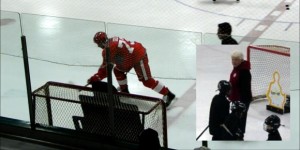
To explain... The main photo is from a drill the Detroit Red Wings were doing. It's kind of a passive drill (in comparison to the way I've run it with my team players), with a coach bothering a Wings forward as he attempts to deflect a shot and then put any rebound home behind what appears to be a "simulated goaltender". The insert shows a tiny version of my SMG -- or "simulated goaler" -- that has been used for years with my youngest players or clinic students.
The forum problem came into play when someone thought I was full of "it" when I said I'd developed something like that years ago. As I recall, the Detroit guys were supposed to be geniuses for arriving at such a drill, and I couldn't have possibly done the same thing 15 or more years before.
You'll have to be the judge of whether that really is a crude "SMG" being used by the Detroit coaches or not (or maybe someone reading this knows for sure). The fact is, it would make sense if it is.
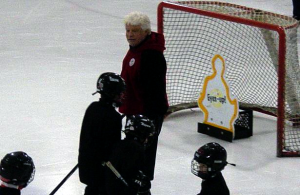
 I was running some scoring camps for Massachusetts and Rhode Island area players, and I was discovering that there was a problem as my younger kids gradually learned the many new moves we were showing them. I mean, our Mite and Squirt aged kids were ultimately getting their moves down pretty nicely, but they were getting discouraged at times when live goalers were lucking into stuffing them. Said yet another way, our kids were often doing everything right, but they weren't getting the positive feedback they deserved, solely because of luck (or even an exceptional goalie stop).
I was running some scoring camps for Massachusetts and Rhode Island area players, and I was discovering that there was a problem as my younger kids gradually learned the many new moves we were showing them. I mean, our Mite and Squirt aged kids were ultimately getting their moves down pretty nicely, but they were getting discouraged at times when live goalers were lucking into stuffing them. Said yet another way, our kids were often doing everything right, but they weren't getting the positive feedback they deserved, solely because of luck (or even an exceptional goalie stop).
I appreciate that "that's the way it goes in our game" -- that even great players win some and lose some. I don't think that has to be the case during the teaching/learning phase, however. In other words, my troubleshooting mind told me that there had to be an intermediate step in the learning process, right between the skills work and the final test against live competition. And that need to problem-solve in hockey was what sent me off to the drawingboard.
In effect, you can call it the "confidence building step" I was looking for, because that's exactly what was gained by ensuring that every good moved worked, and most not-so-good moves didn't. Plain and simple: my kids were getting exact feedback during this next-to-last phase of training.
 You might know that I've used plywood sheets with the corners cut out, and they're okay -- in a pinch. So have I purchased expensive strap-on arrangements -- some with a picture of a goalie on the front, but that has never really satisfied the kind of problem-solving I've been into.
If you can envision the moves my staff and I were teaching in my clinics and camps, only a few resulted in a shot on net -- in other words, a sheet of plywood across a net wasn't going to satisfy all the plays my kids were learning. More often, those moves began with a deke towards one direction and a tuck of the puck in the other.
You might know that I've used plywood sheets with the corners cut out, and they're okay -- in a pinch. So have I purchased expensive strap-on arrangements -- some with a picture of a goalie on the front, but that has never really satisfied the kind of problem-solving I've been into.
If you can envision the moves my staff and I were teaching in my clinics and camps, only a few resulted in a shot on net -- in other words, a sheet of plywood across a net wasn't going to satisfy all the plays my kids were learning. More often, those moves began with a deke towards one direction and a tuck of the puck in the other.
Again, I had a problem to solve -- huh? And, that's what sparked the idea for a three-dimensional, make-believe goalie.
The movable SMG also satisfied a couple of other great skills... For one thing, it could be moved onto any angle -- something that's far more realistic than any lash-on kind of aid. Better yet, we could move that simulated goaler in and out of the net, signifying to our students that they should either make a move or quickly nail a shot.
Readers should know that I used to tow a pretty good sized trailer to my hockey schools. It was jam-packed to the brim, too. Why would that be? Hmmmmmm... How about two answers...
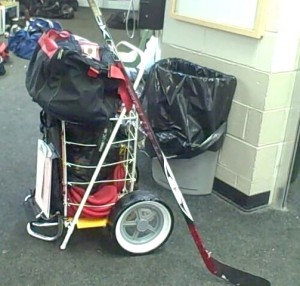 First, I've never taken shortcuts when it came to my players' or students' needs. Even in my weekly clinics or for team practices, members know I carried lots of extras in my equipment cart. There were 80-ish pucks in a bag, about a dozen foam disks I used as small pylons, a bag of colored pucks for special games, a bag of Swedish stickhandling balls for dribbling in the rink runway, spray paint for the ice, a box of chalk for the lockerroom floor or runway, my camcorder case, extra color-coded jerseys, and some things I've forgotten. With that, you you can probably imagine how much more I felt I needed for a long day of hockey school, and with close to 60 kids moving through about four training groups.
First, I've never taken shortcuts when it came to my players' or students' needs. Even in my weekly clinics or for team practices, members know I carried lots of extras in my equipment cart. There were 80-ish pucks in a bag, about a dozen foam disks I used as small pylons, a bag of colored pucks for special games, a bag of Swedish stickhandling balls for dribbling in the rink runway, spray paint for the ice, a box of chalk for the lockerroom floor or runway, my camcorder case, extra color-coded jerseys, and some things I've forgotten. With that, you you can probably imagine how much more I felt I needed for a long day of hockey school, and with close to 60 kids moving through about four training groups.
Second -- and as you know by now, I have this great compulsion to problem-solve in hockey, and develop all sorts of answers to the training problems I saw my students having. So, that trailer was loaded with all sorts of problem-solving items -- to help my kids with specific skills, to help enhance certain physical traits, etc.
Actually, this site is loaded with descriptions of gadgets I made from the problem-solving process. Again, I'm not going to recall them all, but I did just now remember the Net Blocks I carried latched to my cart, those used to lift the back of our practice nets so pucks could slide through. And I remember the Box Hockey kit, the combination stick and puck used to help defensemen with their 1 on 1's, the Russian Half-sticks that helped with my kids' passing skills, and a myriad of gadgets used as simulated defenders on the way to our SMGs. I carried weighted vests, balance beams, all sorts of jumping barriers, and bungee cords for numerous applications. (Someday I'll also tell members more about my Skater's Rhythm-bar, which was a staple of my many clinics and camps.)
Oh, ya, my simulated defenders... I reasoned those out, too, just as I did the SMGs. As I explain in a video about Creating the Early Goal-scorer, a defender can be viewed as only a stick and two legs, with "open triangles" exposed -- under the stick and between the legs, with the areas off to each side of the defender also being open. As can be seen in that video, the defenders I made stemmed from the same aim I had with the SMGs -- to provide my kids an intermediate step between no defender and a real one. And, much like working against an SMG, a young attacker would get the proper feedback while working against one of those simulated D, as the puck either gets through or it doesn't.
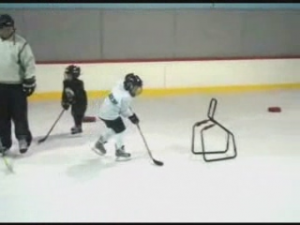 A few years ago, I took a step backwards to help near-beginners. Kids coming out of my Learn-to-play clinic had the chance to play in a league, and I thought I'd give them a head start in attacking -- hey, that's the fun part of our game. For sure, they got to face my SMGs in every weekly clinic, and I even had them going against a bunch of volunteer coaches during those practices, with the coaches just standing still, frozen in a defensive posture -- their skates spread and the stick held out in front.
A few years ago, I took a step backwards to help near-beginners. Kids coming out of my Learn-to-play clinic had the chance to play in a league, and I thought I'd give them a head start in attacking -- hey, that's the fun part of our game. For sure, they got to face my SMGs in every weekly clinic, and I even had them going against a bunch of volunteer coaches during those practices, with the coaches just standing still, frozen in a defensive posture -- their skates spread and the stick held out in front.
We had a decent pre-game period before each of our games, so I ultimately used some nearby skating gadgets to act as stationary defenders. As you can probably imagine from the above photo, those little guys got used to tossing the puck through consecutive defenders' skates, picking the puck up on the other side, and then attacking the goal.
Okay, other than the examples I've given -- here and in the other linked posts, it's not easy to tell anyone how to go about the problem-solving process. Still, I guess we could borrow an idea from some business gurus who are likely smarter than I, because they'd most likely suggest that, "The right answer stems from first asking the right question."
Ya, the right question... With the SMG, it would be about finding an intermediate step between a regular stickhandling or shooting drill and attacking a live goaltender. It was pretty much the same challenge when I arrived at the simulated defenders, where I sought to find an intermediate step between open ice stickhandling drills and attacking a real defender.
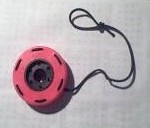 In the case of that device I created to help defensemen, the problem my D were having -- like almost all young defensemen -- was that they were looking down at the puck as an attacker approached, and they were too often going all or nothing when trying to poke-check the puck. So, I guess the question was, "How can I make rushes as close to the real thing as possible, while preventing my D from over playing the puck?" The answer, ultimately, was an attacking coach carrying a stick with a puck affixed, so that my defender knew he couldn't steal the puck. That encouraged my D to mainly focus on the body while still having a chance to practice poke-checking.
In the case of that device I created to help defensemen, the problem my D were having -- like almost all young defensemen -- was that they were looking down at the puck as an attacker approached, and they were too often going all or nothing when trying to poke-check the puck. So, I guess the question was, "How can I make rushes as close to the real thing as possible, while preventing my D from over playing the puck?" The answer, ultimately, was an attacking coach carrying a stick with a puck affixed, so that my defender knew he couldn't steal the puck. That encouraged my D to mainly focus on the body while still having a chance to practice poke-checking.
Then, we have the old Soviets to thank for what I've referred to for years as the Russian Half-sticks... What their coaches must have asked was, "How can we force our players to focus on really soft hands on a catch, and handling the puck between the stick blade's heel and midpoint when sending a pass?"
Ya, that's it, I guess: the idea is to ask the right question or define the problem well. And I think we can do that with just about every phase of the game -- not just for arriving at some new training gadget. In other words, we can adjust our forecheck by defining the problem we're having, and then go about solving that specific problem. I think we could do that to design new breakouts, new attack plays, to arrive at better ways of strengthening, speeding or conditioning our kids, and so forth.
Lastly, while I began this piece on sort of a rant about guys in forums, I really want it to be all about our need to problem-solve in hockey trouble areas. To me, troubleshooting is the measure of a good coach or hockey parent. And, when you reach a sticking point, there's nothing wrong with asking elsewhere -- it's doubtful you're the first to hit a stumbling block.
Actually, I wouldn't mind getting involved in your troubleshooting. In fact, I'd love it if you share it with me, or allow us to go back and forth on it.
*
When you get a chance, also see my article on "The Idea(s) Behind Those “Goal-scorer” Gadgets".

No comments:
Post a Comment